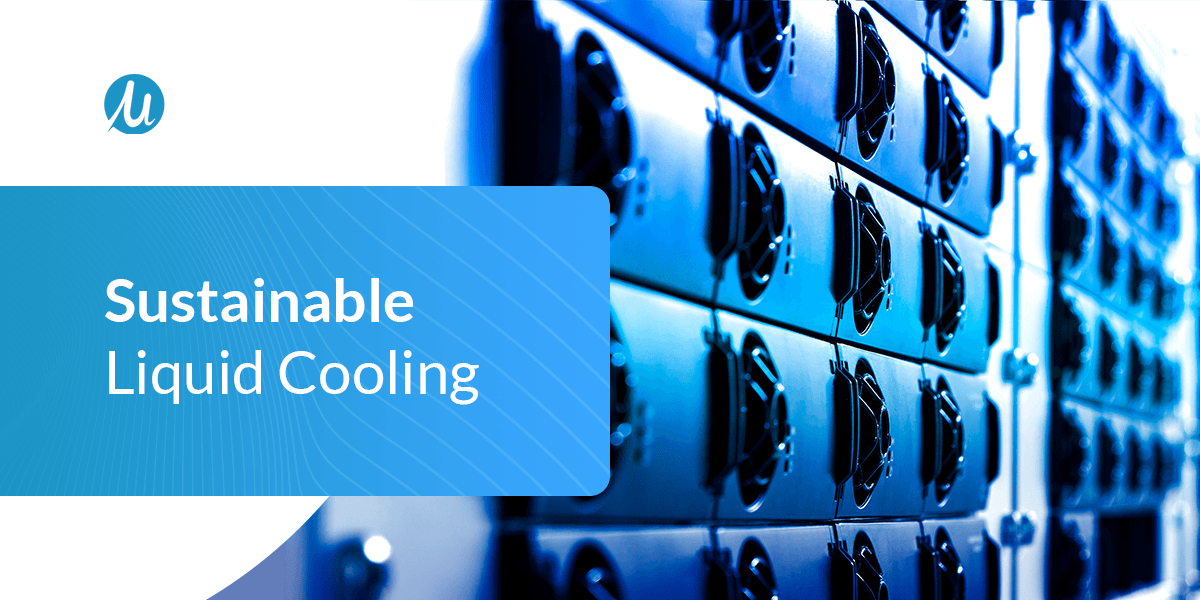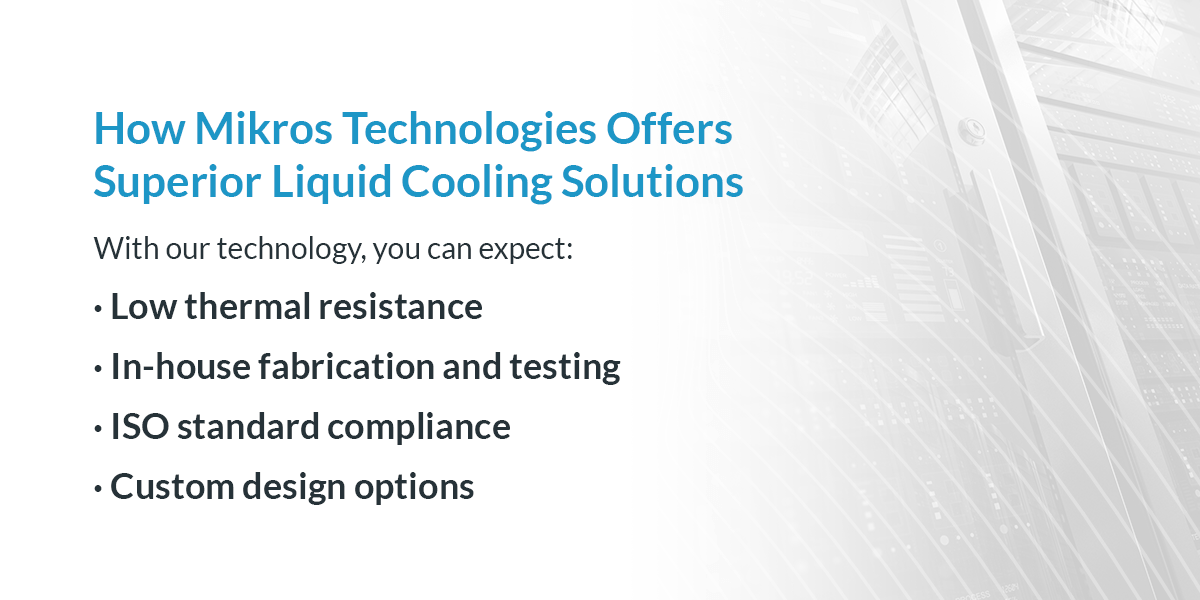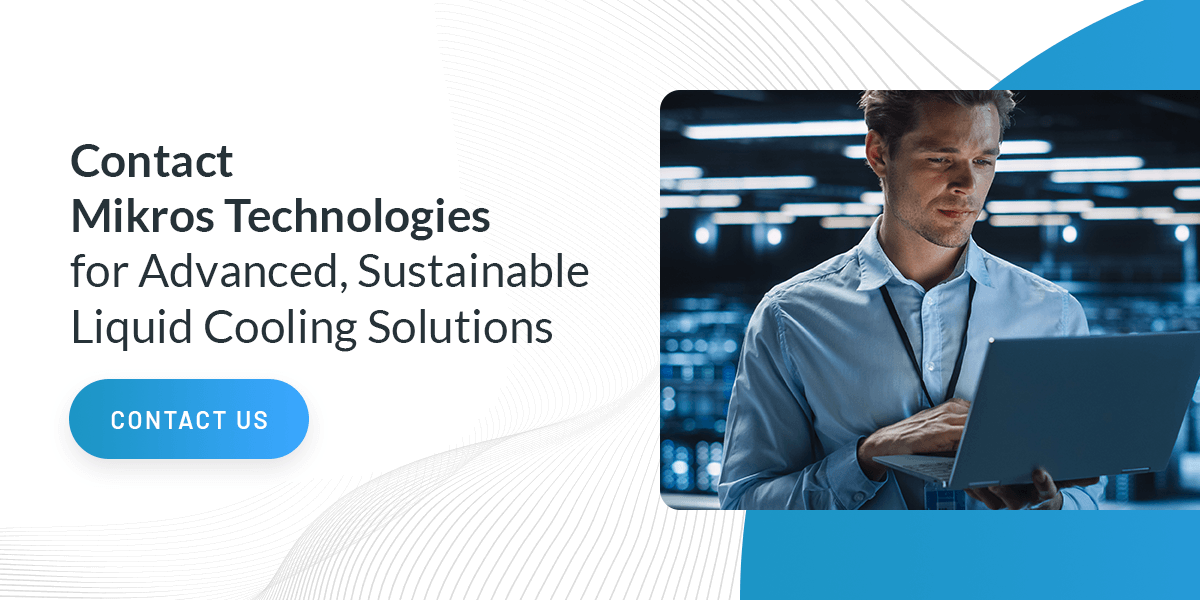Sustainable Liquid Cooling

As data centers become more central to everyday business operations and demands for faster data processing continue to increase, facilities must understand how to manage equipment properly. Powerful data processing can quickly overheat systems without adequate cooling installed.
Thus, liquid cooling has become an ideal solution for the demands of the high-performance computing (HPC) and data center industries.
Benefits of Liquid Cooling for Data Centers
As technology has become more sophisticated, the need for high-powered, near-instant response times and endless, scalable data storage has surged. CPUs are faster than ever, but this level of power and speed comes at a price — heat generation.
Overheating leads to premature computer hardware breakdown, causing outages, and may result in costly damages and irreplaceable data loss if left unchecked. All hardware should have a corresponding cooling system suited to its specific needs, like size, specifications and speed. The better the cooling system, the longer your investment will last, and you can expect higher, more consistent speeds and superior operating performance.
Older processor models have built-in fans and air cooling systems that generate air movement for internal cooling. While this was effective for less demanding CPU tasks, today’s businesses and data centers need something faster, quieter and more resource-efficient — that’s where liquid cooling comes in.
1. Increased Energy Efficiency
Liquid cooling eliminates the need for constant air circulation, significantly reducing utility consumption and boosting your facility’s energy efficiency.
Instead of fans, liquid cooling systems move liquid through processor attachments, including a heat sink, that quickly moves any processing heat from the processor to the cooling liquid. The liquid then cycles through the radiator, transforming the heat into air that it expels from the equipment case. Finally, the liquid returns to the system, repeating the process as long as the machine is in use.
Experts at ComputerWeekly report liquid cooling offers a higher heat capacity than air and 4,000 times the efficiency.
2. Decreased Water Usage
Thanks to today’s focus on improving cooling infrastructure, liquid cooling solutions — like those from Mikros Technologies — are more economical, environmentally responsible and utility-friendly than ever before. Equipment components are smaller, and technology is more adaptable to performance fluctuations. Data centers can also implement water reuse programs to increase resource sustainability and decrease water consumption.
3. Decreased Carbon Footprint
Recent findings suggest global computing has an even larger carbon footprint than the aviation industry, emitting up to 3.9% of the world’s total greenhouse gases. Studies have shown that when data centers use liquid cooling, they can reduce power usage effectiveness, with some reports indicating a PUE below 1.04.
Increasing Demand for Liquid Cooling
Global consumers will spend $3 trillion on IT in 2021, amassing an anticipated 463 exabytes of data generation by 2025. With these growing demands — which show no signs of slowing — the need for liquid cooling options and a robust focus on renewable energy at data centers is evident.
Consumers have also come to expect faster performance in every area of data relations, from individual PC owners to large-scale businesses and tech manufacturers.
Transitioning From Air Cooling to Liquid Cooling
Many older data center facilities were built with air cooling in mind and do not yet have the plumbing in place for rack-level liquid cooling. In these cases, a closed-loop liquid-cooling system with an air-cooled rack is often the best path forward.
The transition of computing components from air cooling to liquid cooling often requires infrastructure investment and planning.
Performance
Liquid cooling dramatically increases the computing power of chips by removing more heat per unit area. Liquid cooling also helps regulate CPU performance, preventing overworking when demand requires more power. Without excessive fan movement, expect quieter operation and the need for fewer sound prevention measures.
Equipment
To properly transition from an air cooling to a liquid cooling system, the necessary equipment is required. For closed-loop systems, a cold plate, pump, radiator, reservoir and tubing are required. For an open-loop system, tubing, fluid disconnect fittings as well as a coolant distribution unit (CDU) are necessary. CDUs can either be in-row or in-rack.
Upkeep
Different liquid cooling types exist, and each has unique maintenance requirements and longevity. Some solutions have aesthetic additives, like dye, or functional additives, like anti-algae mixtures. Any water used in or near an open-loop liquid cooling system should be distilled and free of any non-approved additives. Have a plan to monitor liquid cooling levels and replenish them before they get low enough to impact performance and cause costly setbacks.
Maintenance
Your manufacturer will also give you instructions for periodic flushings and refills that will keep the system clean. Use this time to inspect components, like clamps, for any wear, and consider special additives that can help combat natural component discoloration that may occur with oxidation.

How Mikros Technologies Offers Superior Liquid Cooling Solutions
At Mikros Technologies, our liquid cooling options offer low-pressure drops and low flow rates, so you can enjoy superior performance while consuming less energy. Our liquid cooling solutions can help your data center meet operating goals and create bigger, more efficient data chips, AI algorithms and more.
With our technology, you can expect:
- Highest cooling capacities.
- In-house fabrication and testing.
- ISO standard compliance.
- The ability to increase your thermal budget to apply to all applicable areas of operation, including performance, packaging and long-term reliability.
- Custom design options to meet your facility’s specific space and performance needs.
At Mikros Technologies, our microchannel liquid cooling designs keep processors within their operating temperatures using lower coolant flow rates and needed pressures. Our direct-to-chip cold plates can help data centers meet aggressive energy reduction goals while providing more compute power for larger data sets and more advanced algorithms.
Contact Mikros Technologies for Advanced, Sustainable Liquid Cooling Solutions
When comparing liquid cooling vs. air cooling, you’ll quickly see the benefits of a liquid-based system far outweigh air cooling systems, especially in large-scale applications, like the aviation industry, energy generation and data centers. An effective liquid cooling system can save energy and money while improving performance speeds and reducing operating noise.
Transitioning to a liquid cooling system from an air cooling system is possible with planning. Contact Mikros Technologies to discuss your liquid cooling options and experience the difference sustainable cooling can have on your operations.
